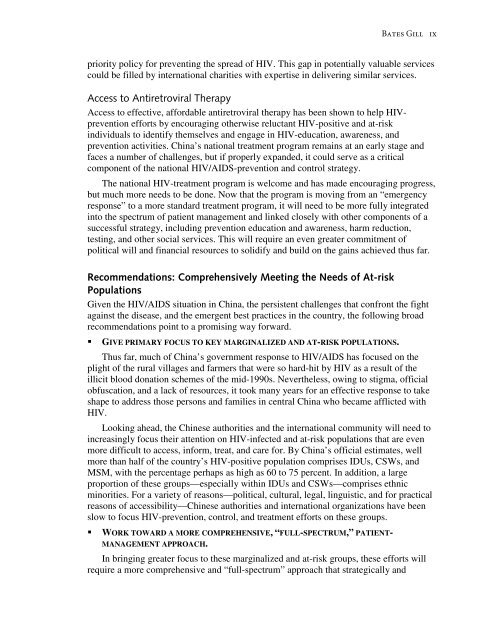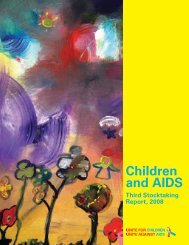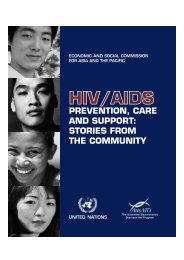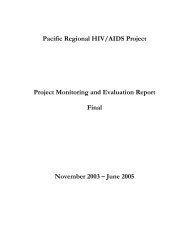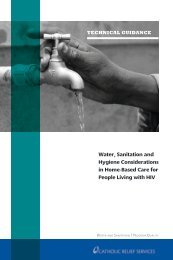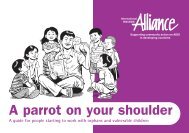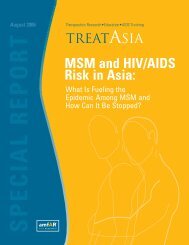Assessing HIV/AIDS Initiatives in China - Center for Strategic and ...
Assessing HIV/AIDS Initiatives in China - Center for Strategic and ...
Assessing HIV/AIDS Initiatives in China - Center for Strategic and ...
Create successful ePaper yourself
Turn your PDF publications into a flip-book with our unique Google optimized e-Paper software.
Bates Gill ix<br />
priority policy <strong>for</strong> prevent<strong>in</strong>g the spread of <strong>HIV</strong>. This gap <strong>in</strong> potentially valuable services<br />
could be filled by <strong>in</strong>ternational charities with expertise <strong>in</strong> deliver<strong>in</strong>g similar services.<br />
Access to Antiretroviral Therapy<br />
Access to effective, af<strong>for</strong>dable antiretroviral therapy has been shown to help <strong>HIV</strong>prevention<br />
ef<strong>for</strong>ts by encourag<strong>in</strong>g otherwise reluctant <strong>HIV</strong>-positive <strong>and</strong> at-risk<br />
<strong>in</strong>dividuals to identify themselves <strong>and</strong> engage <strong>in</strong> <strong>HIV</strong>-education, awareness, <strong>and</strong><br />
prevention activities. Ch<strong>in</strong>a’s national treatment program rema<strong>in</strong>s at an early stage <strong>and</strong><br />
faces a number of challenges, but if properly exp<strong>and</strong>ed, it could serve as a critical<br />
component of the national <strong>HIV</strong>/<strong>AIDS</strong>-prevention <strong>and</strong> control strategy.<br />
The national <strong>HIV</strong>-treatment program is welcome <strong>and</strong> has made encourag<strong>in</strong>g progress,<br />
but much more needs to be done. Now that the program is mov<strong>in</strong>g from an “emergency<br />
response” to a more st<strong>and</strong>ard treatment program, it will need to be more fully <strong>in</strong>tegrated<br />
<strong>in</strong>to the spectrum of patient management <strong>and</strong> l<strong>in</strong>ked closely with other components of a<br />
successful strategy, <strong>in</strong>clud<strong>in</strong>g prevention education <strong>and</strong> awareness, harm reduction,<br />
test<strong>in</strong>g, <strong>and</strong> other social services. This will require an even greater commitment of<br />
political will <strong>and</strong> f<strong>in</strong>ancial resources to solidify <strong>and</strong> build on the ga<strong>in</strong>s achieved thus far.<br />
Recommendations: Comprehensively Meet<strong>in</strong>g the Needs of At-risk<br />
Populations<br />
Given the <strong>HIV</strong>/<strong>AIDS</strong> situation <strong>in</strong> Ch<strong>in</strong>a, the persistent challenges that confront the fight<br />
aga<strong>in</strong>st the disease, <strong>and</strong> the emergent best practices <strong>in</strong> the country, the follow<strong>in</strong>g broad<br />
recommendations po<strong>in</strong>t to a promis<strong>in</strong>g way <strong>for</strong>ward.<br />
• GIVE PRIMARY FOCUS TO KEY MARGINALIZED AND AT-RISK POPULATIONS.<br />
Thus far, much of Ch<strong>in</strong>a’s government response to <strong>HIV</strong>/<strong>AIDS</strong> has focused on the<br />
plight of the rural villages <strong>and</strong> farmers that were so hard-hit by <strong>HIV</strong> as a result of the<br />
illicit blood donation schemes of the mid-1990s. Nevertheless, ow<strong>in</strong>g to stigma, official<br />
obfuscation, <strong>and</strong> a lack of resources, it took many years <strong>for</strong> an effective response to take<br />
shape to address those persons <strong>and</strong> families <strong>in</strong> central Ch<strong>in</strong>a who became afflicted with<br />
<strong>HIV</strong>.<br />
Look<strong>in</strong>g ahead, the Ch<strong>in</strong>ese authorities <strong>and</strong> the <strong>in</strong>ternational community will need to<br />
<strong>in</strong>creas<strong>in</strong>gly focus their attention on <strong>HIV</strong>-<strong>in</strong>fected <strong>and</strong> at-risk populations that are even<br />
more difficult to access, <strong>in</strong><strong>for</strong>m, treat, <strong>and</strong> care <strong>for</strong>. By Ch<strong>in</strong>a’s official estimates, well<br />
more than half of the country’s <strong>HIV</strong>-positive population comprises IDUs, CSWs, <strong>and</strong><br />
MSM, with the percentage perhaps as high as 60 to 75 percent. In addition, a large<br />
proportion of these groups—especially with<strong>in</strong> IDUs <strong>and</strong> CSWs—comprises ethnic<br />
m<strong>in</strong>orities. For a variety of reasons—political, cultural, legal, l<strong>in</strong>guistic, <strong>and</strong> <strong>for</strong> practical<br />
reasons of accessibility—Ch<strong>in</strong>ese authorities <strong>and</strong> <strong>in</strong>ternational organizations have been<br />
slow to focus <strong>HIV</strong>-prevention, control, <strong>and</strong> treatment ef<strong>for</strong>ts on these groups.<br />
• WORK TOWARD A MORE COMPREHENSIVE, “FULL-SPECTRUM,” PATIENT-<br />
MANAGEMENT APPROACH.<br />
In br<strong>in</strong>g<strong>in</strong>g greater focus to these marg<strong>in</strong>alized <strong>and</strong> at-risk groups, these ef<strong>for</strong>ts will<br />
require a more comprehensive <strong>and</strong> “full-spectrum” approach that strategically <strong>and</strong>


